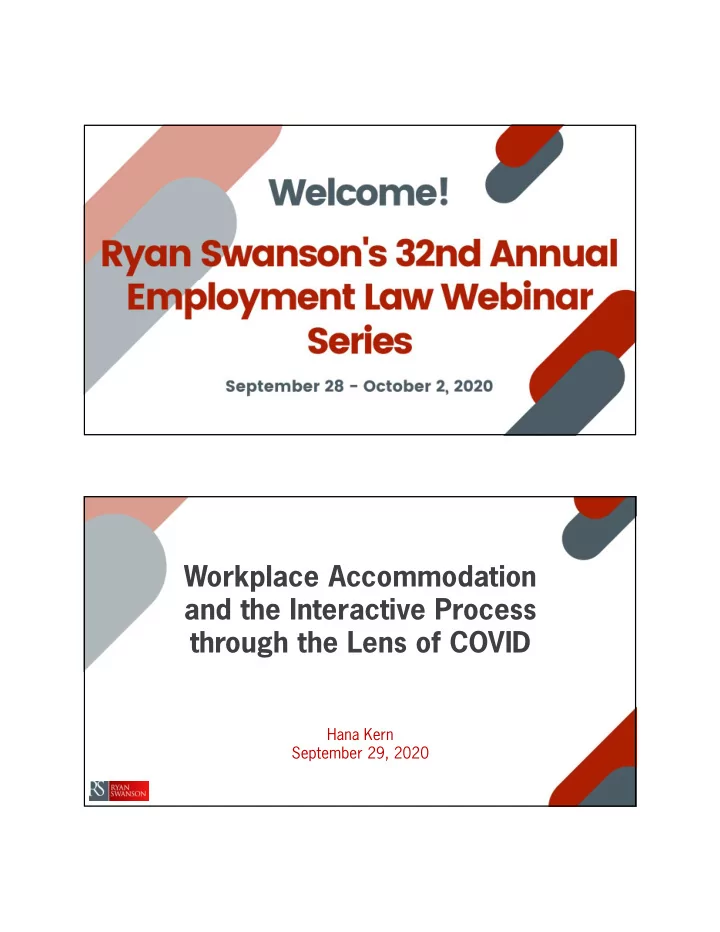

Workplace Accommodation and the Interactive Process through the Lens of COVID Hana Kern September 29, 2020
Which laws apply to my business? ADA (Americans with Disabilities Act), Title 1: Prohibits discrimination against qualified individuals in the employment context. Applies to: a) private employers, b) state and local governments c) employment agencies d) labor unions 15+ employees WLAD (Washington State Law Against Discrimination): 8+ employees High Risk Worker protection- new under COVID: ALL employers in Washington 3 3 Purpose of the laws Prohibit discrimination and allow people with disabilities to have the same opportunities as everyone else; including to have the same employment opportunities as folks without disabilities. 4 4
Applicable during: Job application procedures Hiring Firing Advancement Compensation Job training Other terms, conditions, and privileges of employment 5 5 Is the employee an individual who has qualified for the protections of these laws? ADA: a physical or mental impairment that substantially limits a major life activity, or a history of a substantially limiting impairment. Washington State: the presence of a sensory, physical, or mental impairment that: is medically cognizable or diagnosable; or exists as a record or history. 6 6
Governor Inslee’s High-Risk Worker Proclamation: Provides special protection to high risk workers Proclamation 20-46.1; two extensions and guidance issued Defined as people over 65 and also those with certain chronic underlying health conditions, regardless of age Applies to all Washington employers 7 7 Interactive Process ? How do you do it? What are you required to do? What are you not required to do? What are you not permitted to do? 8 8
What DON’T you have to do? Don’t have to provide whatever they want Don’t have to do something that is an undue hardship Don’t have to fire someone else Don’t have to create a job Don’t have to excuse them from performing the essential functions of the job 9 9 Employers DO have to… Engage interactively with the employee Consider various options which would allow them to perform the essential functions of the job Modify/excuse non-essential job functions Offer an accommodation to continue to perform the essential functions of the job 10 10
Job descriptions – best practices Not required, but a good idea Create them in advance of advertising the job Focus on the result or outcome that the job is to accomplish 11 11 COVID considerations Interim/trial accommodation in light of a changing landscape Undue hardship may look different High risk workers 12 12
High-risk workers Three categories of high-risk workers: 1. Over 65 2. At increased risk per CDC guidelines 3. MIGHT BE at increased risk, under CDC guidelines Applies to: ALL Washington employers 13 13 Employer directives Provide all available options for alternative work assignments to protect the employee from exposure to COVID-19, if requested If a reasonable accommodation is not possible, the employee must be permitted to take leave or file for unemployment benefits Continue to maintain all provide health insurance benefits until the employee returns to work, even if leave has been exhausted 14 14
Employer directives (cont.) May not permanently replacing an employee who exercises rights under the proclamation May not require an employee to work remotely simply because they fall into one of the categories 15 15 Can you ask for medical verification from any of these high-risk employees seeking accommodation under this proclamation? No for 65+ No for “At Risk” Yes for “Might be At Risk” 16 16
Participant Question: What can and can’t you ask? Generally you can ask: Whether the person can perform the essential functions of the job, either with or without accommodation Practical questions about their requested accommodation Request additional information about their requested accommodation Examples of questions you cannot ask: Whether they are disabled The nature and severity of the disability Disability-related medical issues 17 17 Participant Question: What can and can’t you ask? (cont.) COVID-Specific questions you can ask: Whether they have symptoms Whether they have been exposed/been around someone with COVID Whether they have been tested for COVID Temperature checks and self-reporting questionnaires are permitted Examples of COVID-related questions you cannot ask: Whether a family member has COVID Whether they are immunocompromised Whether they have a condition which makes them more susceptible to COVID 18 18
Thank you. Hana Kern Ryan, Swanson & Cleveland, PLLC 206.654.2210 kern@ryanlaw.com www.ryanswansonlaw.com 19
Recommend
More recommend